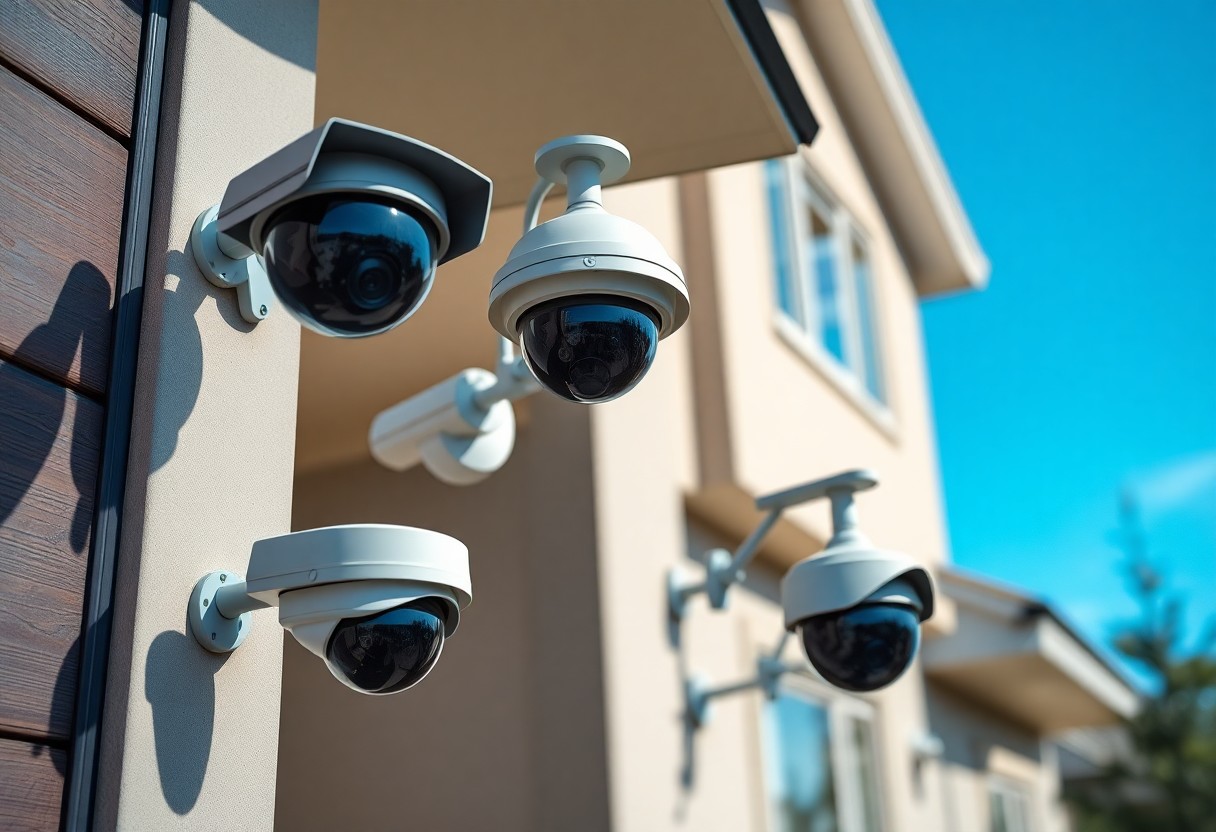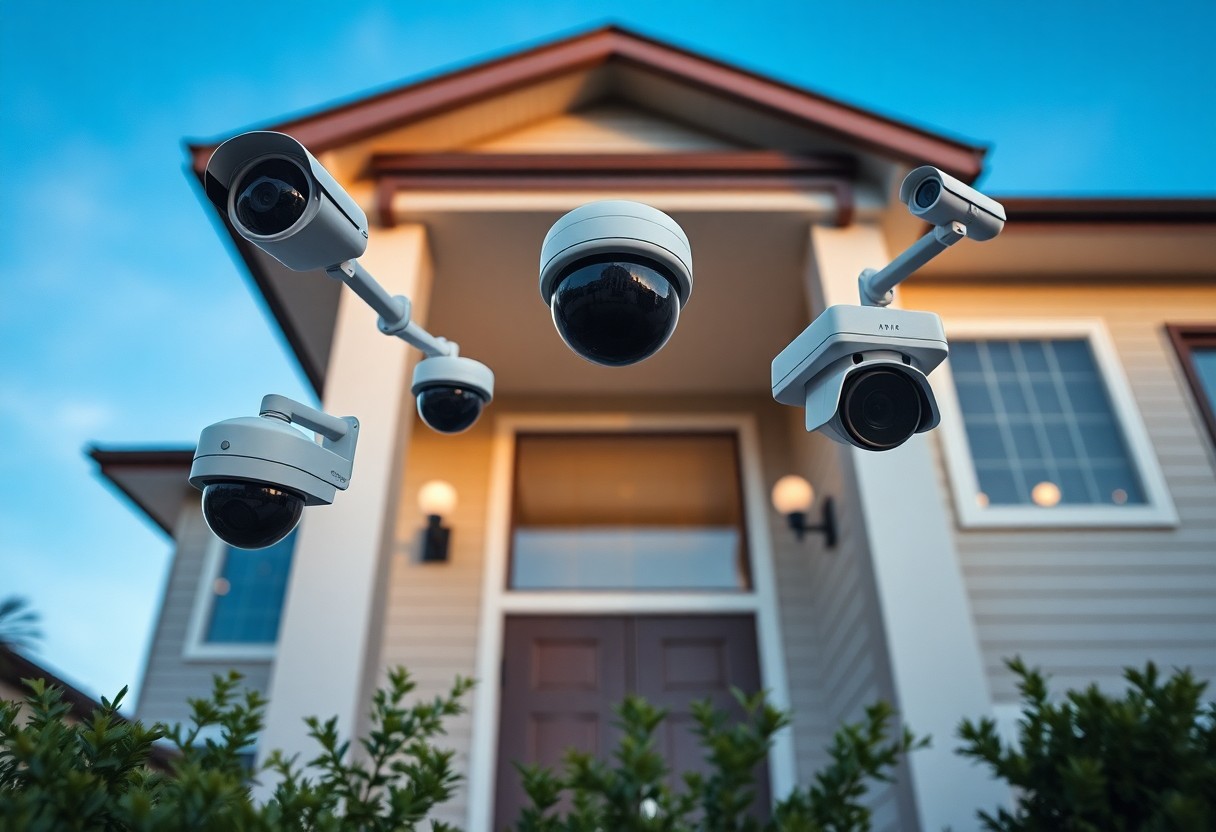Camera technology has advanced significantly, offering you a plethora of options to safeguard your home. Whether you’re looking to deter intruders, keep an eye on pets, or monitor deliveries, selecting the right security camera is important for your peace of mind. In this ultimate guide, you will discover key features to consider, the types of cameras available, and best practices to ensure your home remains secure. Let’s look into the world of security cameras and empower you to make an informed decision for your home security needs.
Contents
- Types of Security Cameras
- Indoor vs. Outdoor Cameras
- Wired vs. Wireless Cameras
- Smart Cameras and Features
- Factors to Consider When Choosing a Camera
- Field of View
- Resolution and Image Quality
- Night Vision Capabilities
- Pros and Cons of Different Security Camera Types
- Advantages of Indoor Cameras
- Drawbacks of Outdoor Cameras
- Tips for Effective Security Camera Setup
- Optimal Placement and Coverage
- Integrating with Home Security Systems
- Step-by-Step Guide to Installation
- Pre-Installation Preparation
- Mounting and Configuration
- Maintenance and Upkeep
- Regular Checks and Cleaning
- Software Updates and System Management
- To wrap up
Types of Security Cameras
While selecting a security camera, you should familiarize yourself with the various types available. Each type serves unique purposes and functions in home security. Consider the following options:
- Dome Cameras
- Bullet Cameras
- PTZ Cameras
- Smart Cameras
- IP Cameras
Assume that you prioritize your security needs to determine the best fit for your home.
| Type | Description |
| Dome Cameras | Compact and discreet, ideal for indoor use. |
| Bullet Cameras | Long and cylindrical, effective for outdoor surveillance. |
| PTZ Cameras | Pan-tilt-zoom capabilities for versatile monitoring. |
| Smart Cameras | Connected devices offering advanced features like motion detection. |
| IP Cameras | Use internet connections for high-quality video streaming. |
Indoor vs. Outdoor Cameras
Even though indoor and outdoor cameras serve different purposes, identifying where you need surveillance is vital. Indoor cameras help monitor activity inside your home, while outdoor cameras safeguard your property from external threats. Consider potential environmental factors, such as weather conditions and lighting, when choosing the right type for your space.
Wired vs. Wireless Cameras
Cameras can be either wired or wireless, each offering its own set of advantages. Wired systems typically ensure a more stable connection and potentially better video quality, while wireless options provide greater flexibility and easier installation.
Cameras require a consistent power supply, which can be more easily achieved with wired systems. However, wireless security cameras often run on batteries or rely on a nearby power source, giving you the freedom to place them anywhere without being tethered to a wall outlet. Understand your setup and preferences before making the choice.
Smart Cameras and Features
Clearly, smart cameras integrate with your home automation systems, providing advanced security features. These include motion detection alerts, two-way audio, and remote access via mobile apps, making it easier for you to monitor your home from anywhere.
Wired smart cameras often offer reliable connectivity and continuous power, enhancing their functionality with built-in features like cloud storage and video analytics. When considering smart cameras, focus on the specifics of connectivity, compatibility with other smart devices, and overall versatility to enhance your home surveillance system.
Factors to Consider When Choosing a Camera
Clearly, selecting the right security camera for your home requires careful consideration of several key factors to ensure you make an informed decision. These include:
- Field of View
- Resolution and Image Quality
- Night Vision Capabilities
- Wired vs. Wireless Options
- Storage Solutions
Recognizing these aspects will help you find a camera that meets your security needs.
Field of View
There’s a significant impact on your surveillance coverage based on the field of view of the camera you choose. A wider field of view allows you to monitor more area with a single camera, reducing the number you need to install.
Resolution and Image Quality
Now, the resolution and image quality play a vital role in your security setup. Higher resolution cameras provide clearer images and allow for better identification of faces and license plates.
Plus, you should consider that a camera with a higher megapixel count not only captures more detail but also helps in various lighting conditions. Clear images are especially beneficial when reviewing footage, giving you the ability to discern critical details that could aid in investigations.
Night Vision Capabilities
Vision is key in maintaining security, especially during nighttime hours. Cameras with night vision capabilities ensure that your property is monitored effectively around the clock.
For instance, some models utilize infrared technology, allowing them to capture high-quality images in complete darkness. Others may offer color night vision that enhances visibility and detail, enabling you to feel more confident about your home’s security even when the sun goes down.

Pros and Cons of Different Security Camera Types
All security cameras come with their unique advantages and disadvantages. It’s vital to weigh these factors when choosing the right camera for your home security needs.
| Camera Type | Pros and Cons |
|---|---|
| Indoor Cameras | Good for monitoring activities, often comes with two-way audio |
| Outdoor Cameras | Weather-resistant, provide a broader view of your property |
| Wireless Cameras | Easy installation, flexible placement options |
| Wired Cameras | Stable connection, often higher quality video |
| Smart Cameras | Integration with smart home systems, advanced features |
Advantages of Indoor Cameras
Camera systems set up indoors play a significant role in keeping you aware of activities happening inside your home. These cameras can help you monitor children and pets while providing you peace of mind when you’re away. Additionally, many indoor cameras often feature two-way audio, allowing you to communicate with family members or pets from anywhere. They are generally less prone to damage from weather conditions, making them a reliable option for indoor security.
Drawbacks of Outdoor Cameras
Clearly, outdoor cameras come with their own set of limitations. They are susceptible to harsh weather elements like rain or extreme temperatures, which can affect performance. Additionally, outdoor cameras may require professional installation due to wiring needs and positioning. You will also encounter issues like lens glare caused by sunlight or reflections, which may lessen image quality, especially in low-light conditions.
Advantages of outdoor security cameras include their ability to provide a comprehensive view of your property’s exterior, acting as a strong deterrent against intruders. However, you must factor in the potential for damage or malfunction due to the elements. It’s vital to choose robust models designed for outdoor use and ensure they’re properly installed and maintained to avoid common drawbacks.
Tips for Effective Security Camera Setup
To maximize the effectiveness of your security cameras, consider the following tips:
- Position cameras at key entry points such as doors and windows.
- Aim for high vantage points to capture a wider area.
- Ensure adequate lighting to maintain clear visibility.
- Regularly check and maintain camera functionality.
- Adjust camera angles for optimal coverage.
Assume that careful positioning and regular maintenance will enhance the security of your home.
Optimal Placement and Coverage
To achieve the best surveillance results, place cameras where they can cover the most area while being less susceptible to tampering. Consider avoiding blind spots and position cameras to capture potential intruder paths, ensuring your home’s perimeter remains well-monitored.
Integrating with Home Security Systems
One effective way to enhance your home security is by integrating your cameras with existing home security systems. This integration enables you to centralize monitoring and control, providing real-time notifications and allowing for easier management of your security settings.
Security camera integration with home security systems can improve your overall safety by providing seamless alerts when suspicious activity is detected. Many modern systems offer compatibility with various devices, such as smartphones and tablets, ensuring you stay informed no matter where you are. With a unified platform, you can monitor all your cameras, receive immediate alerts, and even access recorded footage to review any incidents, thus strengthening your home’s security measures.
Step-by-Step Guide to Installation
For a successful security camera installation, it’s crucial to follow a systematic approach. This guide will ensure you cover everything from pre-installation checks to the final configuration for optimal performance.
| Step | Description |
| 1 | Assess your needs and choose camera placement. |
| 2 | Gather necessary tools and equipment. |
| 3 | Install camera mounts securely. |
| 4 | Connect cables and power sources. |
| 5 | Configure camera settings for your preferences. |
Pre-Installation Preparation
Now, it’s time to prepare for installation. Start by evaluating your home’s layout to identify potential camera locations. Consider factors such as lighting, areas of high traffic, and power outlet availability. Gathering the right tools, including a drill, screwdriver, and mounting hardware, will streamline the process. Also, ensure you have reliable access to the camera’s Wi-Fi network for a smoother setup.
Mounting and Configuration
Configuration begins with securely mounting your cameras in the designated locations. It’s crucial to ensure that they are positioned to cover the desired area of surveillance while avoiding obstructions that may block the view.
Understanding proper mounting techniques is vital to achieving effective coverage. You should use sturdy mounts, followed by drilling pilot holes if necessary. Once mounted, make sure to test the angle of the camera to capture the optimal field of view. After mounting, proceed with the configuration, which includes connecting the camera to your Wi-Fi, adjusting the video settings, and ensuring that motion detection options are tailored to your preferences. Conduct a final test to ensure everything is functioning as desired.

Maintenance and Upkeep
Not only do security cameras provide peace of mind, but proper maintenance and upkeep ensure they function effectively. Regular monitoring and care prolong the life of your investment, keeping your home secure. For further insights, check out The Ultimate Guide to Outdoor Security Cameras: Features ….
Regular Checks and Cleaning
Cleaning your security cameras regularly is important for maintaining clear image quality. Dust, dirt, and weather elements can obstruct the lens, diminishing the footage clarity. Aim to check your cameras monthly to wipe down lenses and housings, ensuring optimal performance year-round.
Software Updates and System Management
Checks on your security camera software are necessary for consistent security. Manufacturers often release updates that address vulnerabilities and improve functionality. Staying current with these updates not only enhances the camera’s performance but also guards against potential cybersecurity threats.
Understanding the importance of software updates and system management helps you maximize your camera’s capabilities. Set reminders to periodically check for updates and ensure that your equipment remains compatible with the latest security protocols. This proactive approach strengthens your home’s defense and provides peace of mind.
To wrap up
Conclusively, selecting the right security camera for your home involves understanding your unique needs, considering vital features, and evaluating installation options. By assessing factors such as camera type, resolution, night vision, and cloud storage, you can ensure added protection for your property. Take the time to compare products and read user reviews, as this will empower you to make a well-informed decision that aligns with your security goals. Investing in the right security camera system will provide peace of mind and enhance the safety of your environment.

Leave a Reply